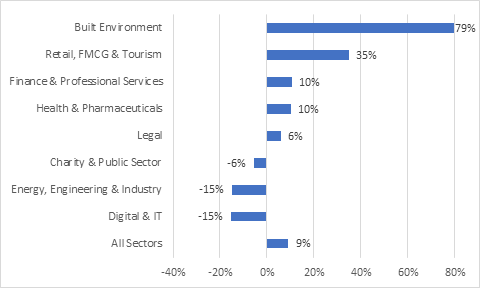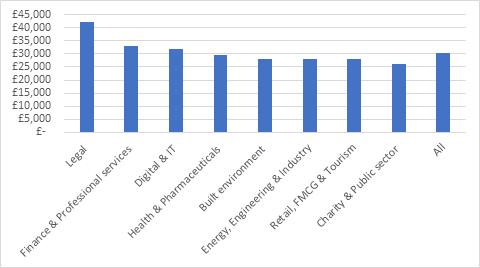Our annual student recruitment report launched last week. ISE researcher Holly Hussein outlines the main changes in the graduate market.
Graduate recruitment is still the mainstay of student employers’ intake, making up 57% of the student hires reported in this year’s ISE Student Recruitment Survey.
It received a knock during the Covid-19 lockdowns of 2020, however graduate recruitment figures appear to be on their way back to pre-pandemic levels and employers plan to continue to scale up recruitment levels over the next year.
A 9% increase in graduate hiring from last year was observed, with the biggest rises in the Built Environment (79%) and Retail, FMCG & Tourism (35%) sectors, suggesting that even those that suffered most during the pandemic are starting to return to normal.
Average (mean) change in graduate hiring numbers by sector 2019/20 to 2020/21

Competition and employer satisfaction
The graduate labour market has been extremely competitive this year. Respondents reported receiving over 1.3m applications for graduate jobs during 2020/2021, with each role receiving an average of 91 applications. This is a 17% increase on last year and the highest number of applications per vacancy that we have on record.
Employer satisfaction is good, with 65% ‘almost always’ able to find the quality of graduates that they require, however perhaps not as high as would be expected given the record numbers of applications per vacancy.
Continuing the trend from last year, the Health & Pharmaceuticals and Retail & FMCG sectors are most positive about the quality of graduates. The Charity & Public sector are the least positive, perhaps due to the private sector increasing their recruitment this year and making it harder for them to find quality candidates.
Almost a third (32%) of respondents had trouble recruiting for at least one role, a decrease on the 40% reported last year, with those struggling most in the Financial & Professional Services, Digital and IT and Energy, Engineering & Industry sectors. The most problematic roles to recruit were IT, Engineering and Technical and Analytical roles, suggesting skills shortages in these areas.
Location
The proportion of graduates located in London has fluctuated over the last few years between 39% and 47% in ISE surveys. This year the number has dropped to its lowest ever level (37%), likely helped by the decision of some employers to enable homeworking for more hires in response to the pandemic.
Acceptance and renege rates
On average, 83% of graduate job offers were accepted, 10% rejected, 5% reneged and 1% deferred. Despite talk of rising renege rates, our data suggests that they have remained stable.
The Charity and Public sector reported the lowest graduate acceptance (72%) and highest graduate renege (14%) rates. Graduates were also less likely to accept a job at a company with less than 250 employees.
Salaries
The typical graduate salary has increased this year from £29,667 to £30,500. Sector differences can be seen with salaries ranging from a median of £25,996 in the Charity and Public sector to £42,250 in the Legal sector.
Median graduate starting salary by sector in 2020/2021

In summary, the graduate market is on its way to returning to ‘normal’ pre-pandemic levels and is forecast to continue to grow and exceed this benchmark by next year.
Competition is extremely high with record numbers of graduates applying for each role, so we recommend that applicants prioritise submitting fewer higher quality applications, rather than adopting the ‘spray and pray’ approach.


0 Comments
Trackbacks/Pingbacks